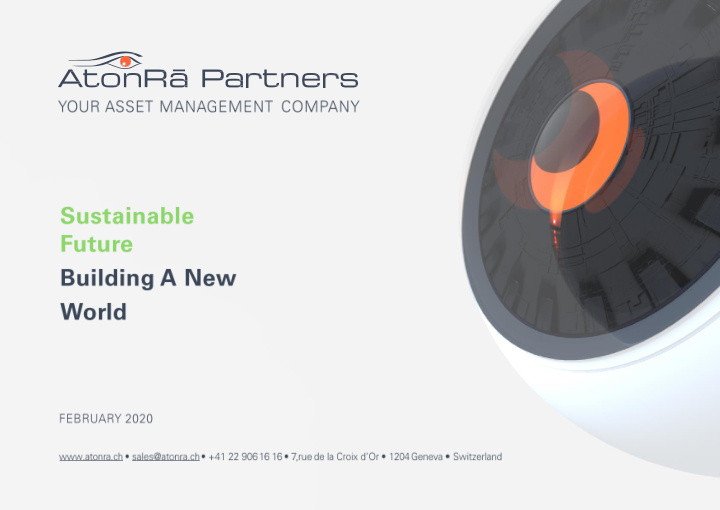



…and it’s affecting our lives in many different ways
Adaptation & Mitigation
Smart City Energy Storage Hyperloop Hydrogen Train Micro-Irrigation Algea Biofuel
CAGR 2018-2024 Stationary Energy Storage ($10B) 38% • Smart Buildings ($62B) 34% • Solar Energy ($633B) 24% • • Smart Transportation ($285B) 23% • Electric Vehicles ($464B) 22% Li-Ion Batteries ($80B) 17% Smart Agriculture ($21B) 14% • Wind Energy ($170B) 13% • Energy Efficient Devices ($1T) 4.3% 12% 22.3% • Hydrogen ($206B) 6% Water Treatment ($664B) 4%
When? To beginning of humankind To end of humankind 200 years ? ~1800 AD What shape will have that transition?
7% 17% 27% 37%
Power Generation Mix NEO 2018 power generation mix Historical world power generation mix 100% Other 90% Solar 80% 70% Nuclear 64% renewables by 2050 Wind 60% & 48% solar and wind Oil 50% Hydro Gas 40% 30% Coal 20% 29% fossil fuels by 10% 2050 0% 1970 1980 1990 2000 2010 2020 2030 2040 2050 Source: Bloomberg NEF; IEA
PV - Installed Capacity (MW) Source: IEA
• Large variety of PV cells type : crystalline, multijunction, • While efficiency grows, costs continue to decline thin-film, organic, etc. • Cumulative production x 2 → Price -24% • Growing cell efficiencies for all types
Solar cells into roof tiles • • Solar cells into building’s facades • •
• • • •
A network of integrated microgrids By 2040, 11B smart appliances are expected to be Provide 185 GW of system flexibility and save deployed in the smart grid worldwide $270B in electricity infrastructure. Generators: energy from small generators and solar panels Storage: energy generated at off-peak times can reduce overall demand on the grid could be stored in batteries for later use Processors: execute special Demand management: use protection can be shift to off-peak schemes in times to save money Sensors: detect disturbances and can microseconds signal for areas to be isolated Smart appliances: can shut off in response to frequency fluctuations
Energy Management Phasor Distribution Grid Systems Measurement Units Management Advanced Metering Transmission Renewable Infrastructure Enhancement Generation Smart Appliances Integration
Trend Objectives • Reduction of Cobalt Content ( ~ 20% to ~ 6%) • Reduce cost • Improvement of anode graphite structure • Increase energy density (addition of silicon) to improve charging rates • Improve charging rates • Development of gel-like electrolyte material • Improve battery safety Sources: IEA analysis based on Meeus (2018); Nationale Plattform Elektromobilitat (2016); NEDO (2018); Howell (2016); Pillot (2017).
• • • • • • • Source: Cenex
Shipping Aviation Rail
Li-Ion Batteries Pumped-Hydro Compressed Air Flywheels
Energy & Power Density Lifespan Discharge Time Overall Cost
Agriculture Industrial Municipalities/ Households
Source: focusingfuture.com
W ater I nnovation
1 kg of Rice 1 kg of Chocolate 1 kg of Beef 1 L of Biofuel
Drilling, Seeding and Spraying Fertigation Water management Livestock Monitoring Aerial Crop Monitoring
Precision Farming • High precision positioning systems • Sensors and remote sensing • Integrated electronic communications Livestock Monitoring • Understand feeding and drinking habbits • Help fend off disease or infections • Protects Animals
→
Smart Cities & Buildings Solar & Wind Energy Efficiency 20-25% average growth Smart Transportation Smart Agriculture Smart Grid Energy Storage Water & Wastewater Treatment →
• • • •
SECURITY HEALTHCARE SUSTAINABLE AI AND MOBILE BIOTECHNOLOGY FINTECH BIONICS M&A FUTURE ROBOTICS AND SPACE PAYMENTS
Recommend
More recommend